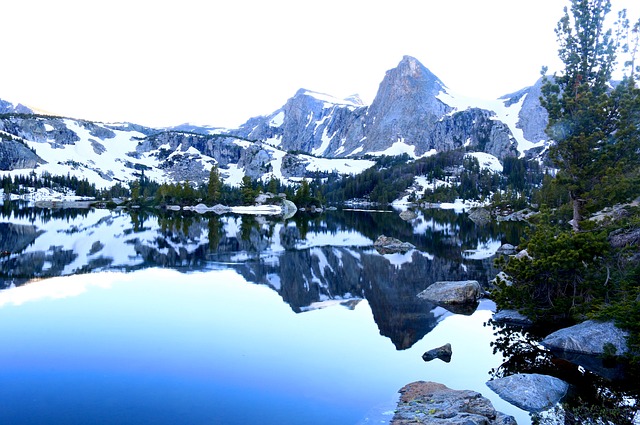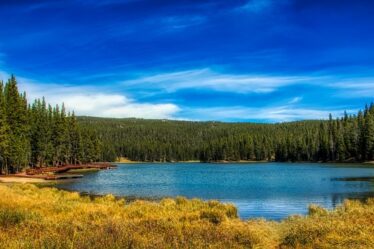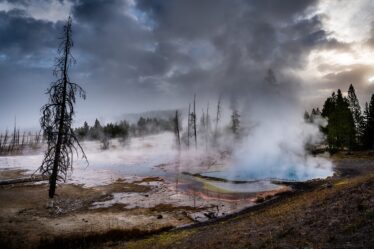
The Wind River Range in Wyoming is a hidden gem in the United States, offering some of the most stunning and remote wilderness experiences in the country. Spanning over 100 miles of the Rocky Mountains, this range is a paradise for outdoor enthusiasts, boasting dramatic peaks, pristine alpine lakes, and abundant wildlife. This detailed guide will take you through the best that the Wind River Range has to offer, from its trails and climbing routes to its rich natural history and practical tips for your visit.
Geographical Overview
The Wind River Range is located in western Wyoming and forms part of the larger Rocky Mountains. The range stretches from the Green River Basin to the Great Divide Basin and includes several notable peaks, including Gannett Peak, the highest point in Wyoming at 13,809 feet. The range is divided between the Bridger-Teton National Forest and the Shoshone National Forest, and it is also home to the Wind River Indian Reservation.
Major Peaks
Gannett Peak
Gannett Peak is the crown jewel of the Wind River Range and a challenging destination for climbers. It is the highest peak in Wyoming and one of the most difficult state high points to reach in the lower 48 states. The standard route involves a strenuous multi-day hike and technical glacier travel, making it suitable only for experienced mountaineers.
Fremont Peak
Standing at 13,745 feet, Fremont Peak is the third-highest peak in Wyoming. It offers a slightly less technical climb compared to Gannett Peak but still requires solid mountaineering skills. The views from the summit are spectacular, with panoramic vistas of the surrounding peaks and valleys.
Wind River Peak
Wind River Peak, at 13,192 feet, is the southernmost 13er in the range. It is accessible via a long hike through beautiful alpine terrain, making it a popular destination for both climbers and hikers seeking solitude and stunning landscapes.
Hiking and Backpacking
The Wind River Range offers some of the best hiking and backpacking opportunities in the United States. The range is home to a vast network of trails, ranging from short day hikes to extended backpacking trips.
Cirque of the Towers
The Cirque of the Towers is one of the most popular destinations in the Wind River Range, known for its dramatic granite spires and stunning alpine scenery. The Cirque can be accessed via the Big Sandy Trailhead, and the hike to the Cirque is about 10 miles round trip. For those seeking a longer adventure, the 30-mile loop around the Cirque offers an unforgettable backpacking experience.
Titcomb Basin
Titcomb Basin is another iconic destination in the Wind River Range, renowned for its breathtaking scenery and numerous alpine lakes. The basin is accessible from the Elkhart Park Trailhead, and the hike to the basin is approximately 15 miles one way. The route passes through dense forests, meadows, and along the shores of stunning lakes, providing ample opportunities for fishing and wildlife viewing.
Glacier Trail
The Glacier Trail is a challenging and rewarding backpacking route that provides access to Gannett Peak. The trail starts at the Glacier Trailhead near Dubois and traverses 25 miles of rugged terrain, including high mountain passes and pristine valleys. This trail is recommended for experienced backpackers and climbers seeking a true wilderness adventure.
Climbing and Mountaineering
The Wind River Range is a paradise for climbers, offering a variety of routes on its granite peaks. From technical rock climbing to alpine ascents, there is something for every level of climber.
Wolf’s Head
Wolf’s Head is a classic climb in the Cirque of the Towers, known for its exposed ridge and stunning views. The East Ridge route is the most popular, offering a moderate climb with spectacular scenery.
Pingora Peak
Pingora Peak is another popular climbing destination in the Cirque of the Towers. The Northeast Face route is considered one of the 50 classic climbs in North America, offering a mix of technical rock climbing and breathtaking views.
Mount Helen
Mount Helen, located in Titcomb Basin, offers a variety of climbing routes on its rugged granite faces. The East Ridge is a popular route, providing a challenging climb with rewarding views of the surrounding peaks and valleys.
Wildlife and Natural History
The Wind River Range is home to a diverse array of wildlife, including elk, moose, black bears, and bighorn sheep. The range is also an important habitat for grizzly bears, which have been reintroduced to the area in recent years. Birdwatchers will find plenty to see as well, with species such as the golden eagle, peregrine falcon, and various songbirds inhabiting the region.
The geological history of the Wind River Range is equally fascinating, with its granite peaks dating back over a billion years. The range was shaped by glacial activity during the last ice age, leaving behind stunning alpine lakes and valleys.
Practical Tips for Visiting
Permits and Regulations
While no permits are required for most day hikes and backpacking trips in the Wind River Range, certain areas may have specific regulations, especially within the Bridger Wilderness and Popo Agie Wilderness. Always check with the local ranger stations for up-to-date information on permits and regulations.
Best Time to Visit
The best time to visit the Wind River Range is from late June to early September when the weather is mild, and the trails are mostly snow-free. However, be prepared for sudden weather changes, as the high-altitude environment can bring cold temperatures and storms even in the summer.
Preparation and Safety
The Wind River Range is a remote and rugged wilderness, so proper preparation is essential. Always carry a detailed map, compass, and GPS device. Make sure to bring sufficient food, water, and camping gear, and be prepared for bear encounters by carrying bear spray and following proper food storage practices. Due to the challenging terrain and potential for altitude sickness, it’s important to be in good physical condition and acclimate properly.
Conclusion
The Wind River Range is a true wilderness paradise, offering some of the most spectacular and remote outdoor experiences in the United States. Whether you’re an avid hiker, a seasoned climber, or simply someone who appreciates stunning natural beauty, the Wind River Range has something to offer. From the iconic peaks of Gannett and Fremont to the serene alpine lakes of Titcomb Basin and the Cirque of the Towers, this mountain range promises an unforgettable adventure for all who venture into its rugged embrace.


